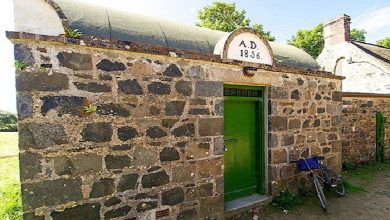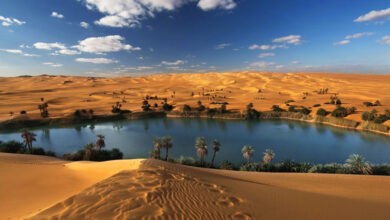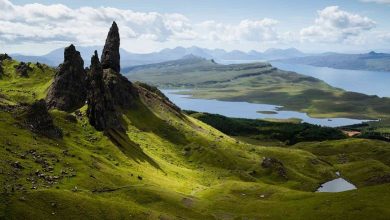Incredible Ghost Islands – an Arctic Mystery

The literary adventure novel “Sannikov Land”, written by the famous in the USSR candidate of geological and geographical sciences author Vladimir Obruchev, saw the light of day in 1926. This work of fiction sparked great interest in the mysterious unconquered part of the land in the middle of the seas of the far North.
In 1973, directors Albert Mkrtchyan and Leonid Popov made a feature film based on the novel of the same name. The film was about the hard everyday life of explorers, the struggle of strong characters, and the sweet moment of discovery by the hero of the picture of a new, previously unknown, northern land. Is the feature film based on real facts, or is it just a skillfully filmed fictional plot by screenwriters Vladislav Fedoseev and Mark Zakharov to attract the attention of the audience?
Historical sketches tell us that, indeed in 1810, the Imperial Russian Geographical Society organized a polar expedition, intending to describe and make an accurate map of the Novosibirsk islands archipelago. During this voyage, reaching the northern tip of Kotelny Island, the discoverer Yakov Sannikov considered a new piece of land not marked anywhere before.
The head of the expedition, Matvey Gedenstrom, wrote in his travel journal that the group discovered, to the northwest of their location, 70 kilometers away (a little over 70 kilometers), rocky mountains which appeared as if from nowhere. Yakov Sannikov’s report indicated three rocky patches of land that were seen. However, Matvey Gedenstrom charted only two of them, referring to a thorough examination of the discovery, during which it was discovered that one island was entirely a thickness of the ice and a cluster of ice hummocks of enormous magnitude.
Maybe at that moment there was a heavy fog, and with almost zero visibility human imagination drew in the minds of polar explorers such a desirable new part of the land, as happens, for example, in the sands of the desert all the well-known ghostly mirages.
In December 1818, the Naval Ministry in St. Petersburg received a document containing the testimony of several representatives of the indigenous people of the North about the existence, to the east of New Siberia Island, of an unknown land inhabited by wild people. The Russian government decided to mount two northern research expeditions at once. One, along the Kolyma River, was led by the Russian navigator Ferdinand Wrangel, while Admiral Peter Anjou led the other expedition along the Yane River. Both prospecting groups moved toward the Novosibirsk Islands archipelago.
In March 1821, the expedition group of polar explorers Peter Anjou finally left the mouth of the river Yana, continued northward, and soon reached Kotel’ny island in the archipelago of Novosibirsk islands. The weather conditions were not favorable because of the very low temperatures, the severe cold stopped even the chronometers. However, the expedition leader decided to move on to the North, and in early April, the team of polar explorers set off. Having reached the island’s northernmost point, the explorers were disappointed to see an open horizon and flat ice for many kilometers. Nevertheless, breaking through the ice hummocks, the group continued for two more days in the direction of the coordinates marked by Sannikov, but to no avail.
In the middle of 1886, the outstanding Russian geologist Thol Eduard Vasilyevich studied Kotelny Island. On August 13, the weather was perfectly clear. Thanks to the excellent visibility, he recognized the contours of the mountains, connecting the northeast with the low-lying land. He could see these uplands so well that he was even able to calculate the approximate distance of 150 versts, and suggested the magmatic composition of their rocky basalt rocks. Unfortunately, the geologist was never able to get closer to the visible land of Sannikov that year, nor later during his next polar expedition in the spring of 1893, when the scientist again saw the uninhabited mysterious northern land.
The data obtained by Sannikov, Gedenstrom, and Tol have indirect confirmation. The Chukchi have long noticed that birds fly further north beyond the Novosibirsk islands in summer and return here in the fall with their grown-up offspring. So, somewhere to the North of the archipelago there is an invisible land where migratory birds nest.
The second indirect confirmation of the hypothesis of the new land existence is the structure of the Laptev Sea bottom. More than half of this water body is occupied by shallow waters up to 50 meters deep. The formation of such a shelf is due to the fact that tens of thousands of years ago the sea level was much lower, and the entire territory of the modern shallow water formed a single continent. Often fishermen’s ships in these places bump into a shoal or a sandbar, and therefore there is a high probability of finding a new island that has risen out of the water.
Explorers have always sought the mystical undiscovered land because the discovery of a new land in the North would make a huge invaluable contribution to the development of such sciences as geology, paleontology, oceanology, cartography, meteorology, and a number of other natural scientific disciplines.
According to modern scientists, Sannikov Land really existed in the nineteenth century and consisted mainly of fossil ice, the age of about one million years, the same lies up to three thousand meters deep on the mainland. As a result of weathering and destruction of the upper rocks, fossil ice previously protected by them under the influence of warm air, sea waves, and sunlight quickly melted, and soon the island disappeared.
No polar explorer during the nineteenth and twentieth centuries, and now the twenty-first digital century, with all its electronic power of modern icebreakers, aviation, and smart space satellites capable of capturing from orbit objects of any size and distance in space, has ever managed to find the unconquered land.




